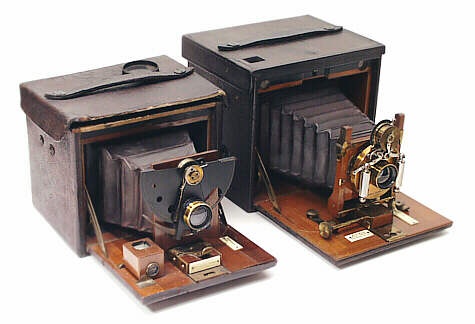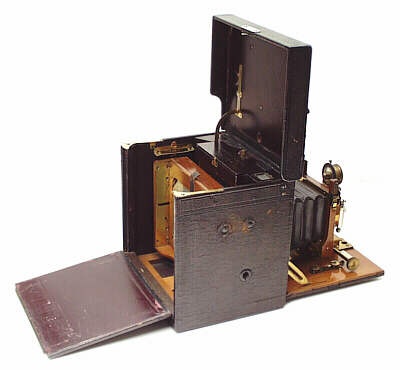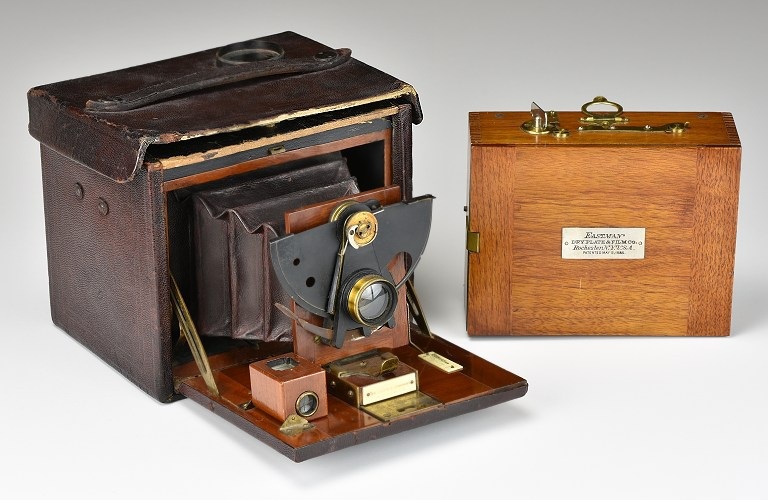|
|





Copyright ©2001 - 2018 by Rob Niederman - ALL RIGHTS RESERVED
Return to the Self-Casing Cameras page
In 1890, George Eastman introduced a new self-casing camera
that was the first to garner wide public acceptance. While not the
first self-casing camera made in America, it is historically
interesting as the first to accept rollfilm.
The innovative body pattern was widely copied by numerous makers including the American Optical Company's 1891 The Henry Clay Camera, Blair Camera Company's 1892 Blair Folding Hawk-Eye No.1, Rochester Optical and many others. The cameras represented an ideal compromise between larger view cameras and inexpensive rollfilm box cameras for the serious amateur market.
In 1892, the Folding Kodak Camera series was updated to use double plate holders. Kodak also made versions that only used plates called Glass Plate Folding Kodaks.
Having been originally built for rollfilm holders, the Folding Kodak cameras used a top-loading design. While functional, the top load design had its flaws. In use, the camera proved to be somewhat clumsy and the leather hinge connecting the top lid to the body often tore apart. As such, nearly all Folding Kodaks are found with separated or missing lids.
The innovative body pattern was widely copied by numerous makers including the American Optical Company's 1891 The Henry Clay Camera, Blair Camera Company's 1892 Blair Folding Hawk-Eye No.1, Rochester Optical and many others. The cameras represented an ideal compromise between larger view cameras and inexpensive rollfilm box cameras for the serious amateur market.
In 1892, the Folding Kodak Camera series was updated to use double plate holders. Kodak also made versions that only used plates called Glass Plate Folding Kodaks.
Having been originally built for rollfilm holders, the Folding Kodak cameras used a top-loading design. While functional, the top load design had its flaws. In use, the camera proved to be somewhat clumsy and the leather hinge connecting the top lid to the body often tore apart. As such, nearly all Folding Kodaks are found with separated or missing lids.
No.4 Folding Kodak Cameras, 1890-97
Eastman Kodak Company. Rochester, NY.
Eastman Kodak Company. Rochester, NY.
Two No.4 Folding Kodaks representing the first and last years of production.
Early 1890 model with "Eastman's Wing" shutter (left) and late 1897 model (right).
Early 1890 model with "Eastman's Wing" shutter (left) and late 1897 model (right).
Later models that incorporated plateholders required a change in the body design. The rear of the camera was modified to open (drop down) for photographers to view a groundglass
when composing an image (as shown at right). For those who purchased early models, Kodak offered to convert older cameras to use double plateholders for $10.
The original price of $50 for the 1890 model (roughly equivalent to $1,384 in year 2017 currency) was very expensive for the time, which may explain the scarcity of these cameras. By the mid-1890s, competitors were introducing smaller, inexpensive versions with average prices in the $8 to $25 range.
Both cameras shown on this webpage were found with their original rollfilm holders with serial numbers that match the body.
The original price of $50 for the 1890 model (roughly equivalent to $1,384 in year 2017 currency) was very expensive for the time, which may explain the scarcity of these cameras. By the mid-1890s, competitors were introducing smaller, inexpensive versions with average prices in the $8 to $25 range.
Both cameras shown on this webpage were found with their original rollfilm holders with serial numbers that match the body.